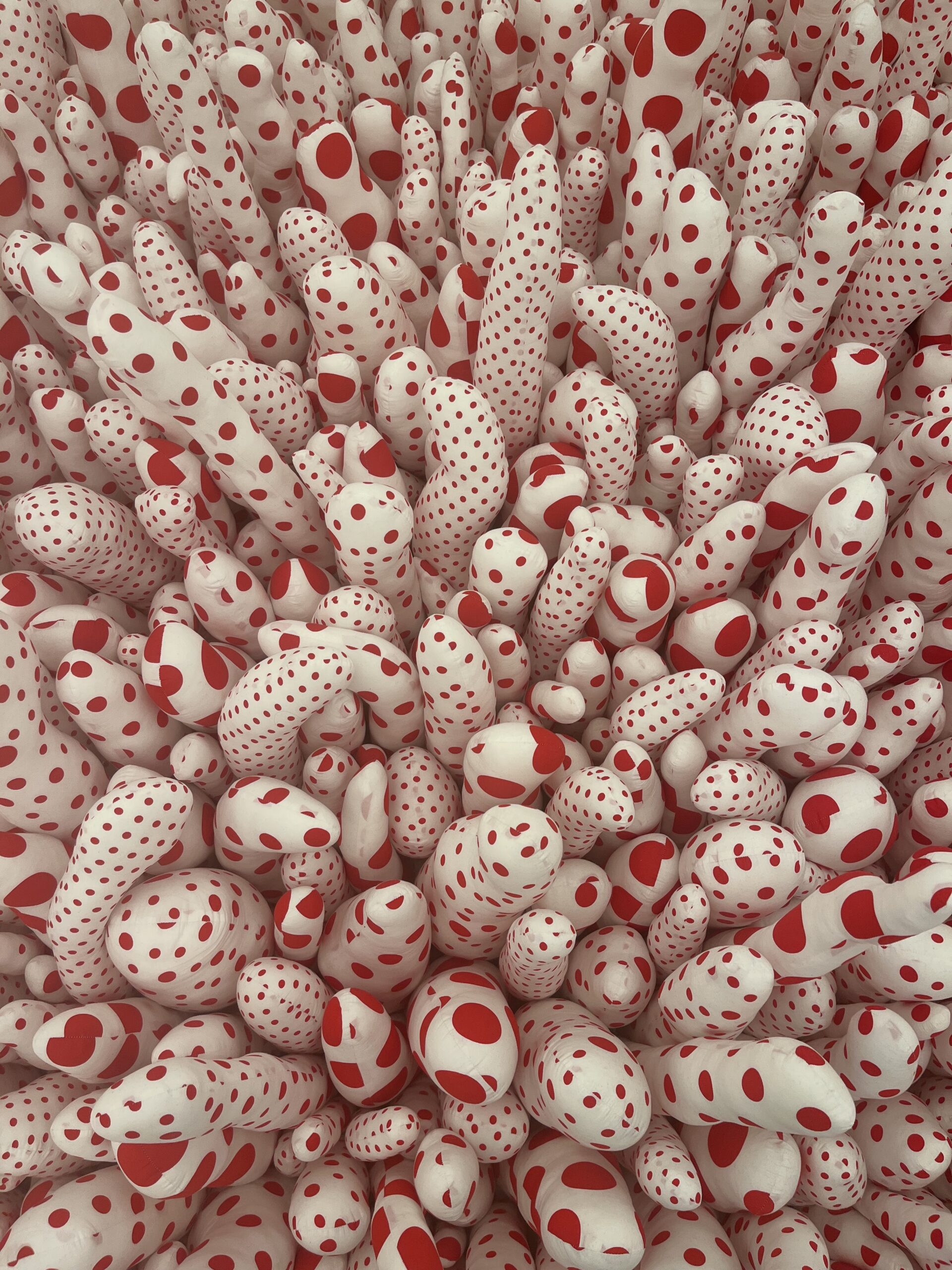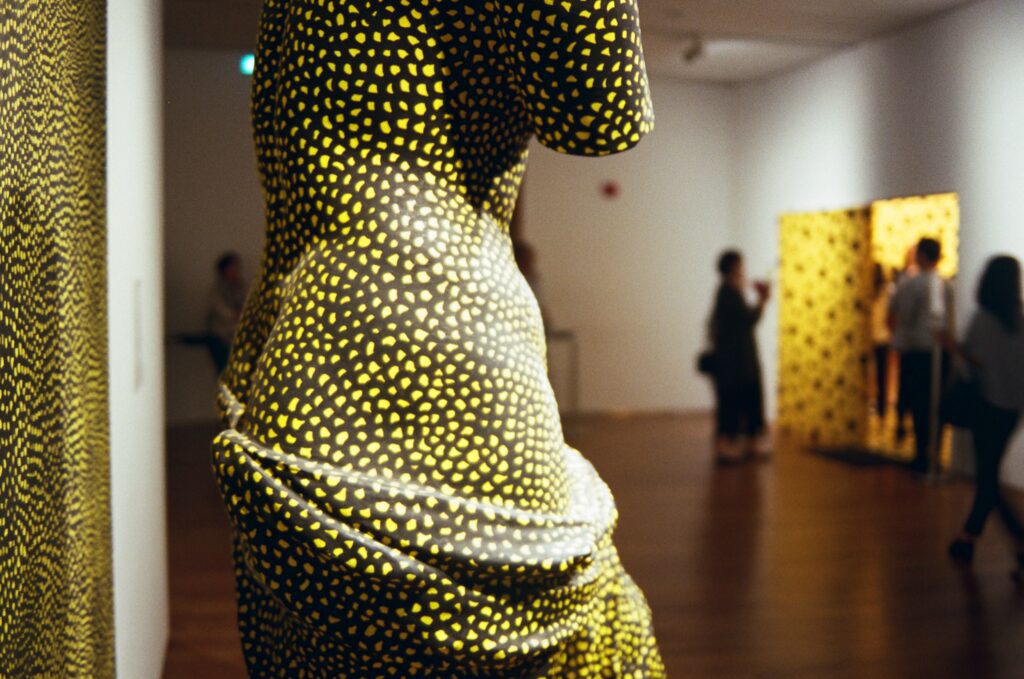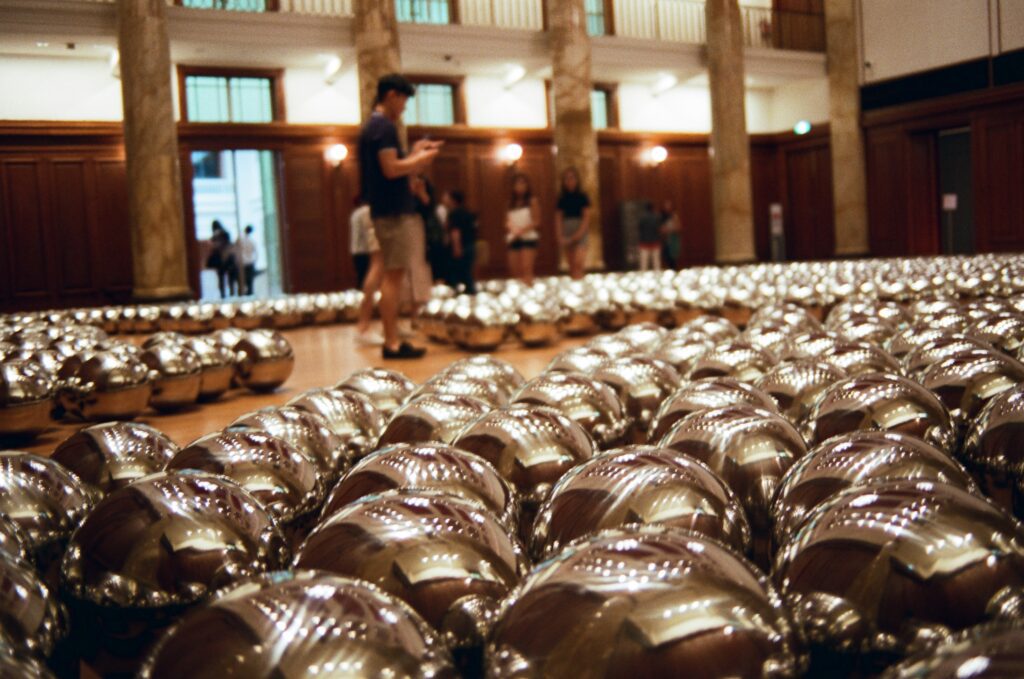
Understanding Sexuality in Yayoi Kusama’s Art
Yayoi Kusama is a Japanese artist known for her avant-garde and minimalist work in a variety of mediums, including painting, sculpture, installation, performance art and literature.
Kusama began her career in the 1950s and quickly gained recognition for her abstract, dot-covered paintings and sculptures. Throughout her career, she has been associated with the avant-garde movements of minimalism, pop art and feminist art. She has also been a pioneer in the use of mirror rooms and infinity rooms as immersive installation pieces. Kusama has also struggled with mental health and has spent much of her life in a mental institution, where she continues to create art to this day.
At 93 years of age, Yayoi Kusama still holds a powerful grip on the scope of Contemporary Art. Her resilience and use of her mental illness to provide a unique perspective in her art is something that has bolstered her success.
She has had major retrospectives of her work at institutions such as the Whitney Museum of American Art in New York City, the Centre Georges Pompidou in Paris, and the Tate Modern in London.
Kusama’s work often features phallic protrusions and vaginal imagery, which she uses to challenge societal norms and taboos surrounding sexuality and the body.
For example, Kusama’s sculpture Accumulation No. 1 (1962) is made up of soft, bulbous forms that resemble body parts and are covered in polka dots, which Kusama has said represent the “infinity of time and space.”
Kusama has also used her body as a medium in her performance art, such as Naked Happening (1968), in which she and a group of other performers painted polka dots on their naked bodies.
Kusama’s use of sexuality in her work subverts societal expectations and encourages viewers to question their beliefs and perceptions about the body and sexuality.
Who is Yayoi Kusama?
Yayoi Kusama is a Japanese artist known for her contributions to contemporary art. Born in Matsumoto, Japan in 1929, Kusama began her art career in the 1950s and quickly gained recognition for her avant-garde style.
She moved to New York in 1958 and became associated with the contemporary art scene there. She was part of the same artistic circles as artists such as Andy Warhol, and her work was exhibited alongside his in several galleries.
Kusama is best known for her use of repetitive patterns and polka dots, as well as her use of phallic shapes and sexual themes. She is also known for her development of the soft sculpture, a type of sculpture made from soft materials such as fabric, foam and paper.
Her work is characterized by its bold and confrontational imagery and themes, and its exploration of the themes of desire, individuality and self-expression. Kusama has continued to create and exhibit her work throughout her long career, and her art remains an important influence on contemporary art and discussions of sexuality and gender.
An Overview of Kusama’s Art Style and Themes

Yayoi Kusama is considered one of the most important contemporary artists working today and is known for using polka dots, nets and infinity rooms.
Kusama’s work often reflects her own struggles with mental illness, and many of her pieces are meant to evoke the universe’s infinite nature. She works in various mediums, including painting, sculpture and installation art, especially her infinity rooms.
Her work is also characterized by bright and bold colors, often in the form of polka dots, which has become her signature style. Kusama’s use of dots creates a sense of endlessness and repetition, which reflects her own struggles with mental illness. The dots also function as a way for the artist to express her feelings of being overwhelmed by the world around her.
In addition to dots, Kusama also uses other patterns and shapes in her work, such as nets, which symbolize the confinement and entrapment she feels.
Kusama’s use of patterns and shapes, along with her use of bright colors, creates an immersive and mesmerizing experience for the viewer. It creates an illusion of depth and movement, which can be disorienting and overwhelming.
Read More: Understanding Yayoi Kusama’s Pumpkin Motif
Sexuality in Kusama’s Art

Her works often depict phallic shapes and repetitive patterns, which she has said are meant to represent the human obsession with sex and desire. Kusama’s art also explores themes of self-obliteration and the loss of self in the face of infinite repetition.
Her use of sexual imagery and themes in her work has been described as a way to confront societal taboos and to express the power of the individual in the face of societal conformity.
Ties To The Feminist Movement
These sexual themes in Kusama’s art are closely related to the feminist movement, as they challenge traditional ideas of femininity and gender roles. Kusama’s use of phallic imagery and bold, assertive forms in her art can be seen as a way of subverting societal expectations and norms surrounding female sexuality.
Furthermore, Kusama’s use of self-portraiture in her art can also be seen as a form of feminist self-representation, as it provides a powerful representation of female sexuality.
Examples of Sexuality in Yayoi Kusama’s art
Phalli’s Field is a work by Yayoi Kusama that was first exhibited in 1965. It is an installation piece that consists of a large field of polka-dotted phallic shapes arranged on the ground. The phallic shapes are made of soft sculptures made of fabric, foam and paper.
The repetitive patterns and phallic shapes used in the work are meant to represent the human obsession with sex and desire. The work is considered one of Kusama’s most important early works and it continues to be a significant piece within her oeuvre.
Narcissus Garden is one of Yayoi Kusama’s most famous works. It is an installation of mirrored stainless steel spheres that are placed on the ground. The piece is meant to be a commentary on human narcissism and the ways in which people are often consumed by their own reflection. The piece was originally presented in Venice at the 1966 Biennale, and since then it has been exhibited in various locations worldwide.
Infinity Mirrored Room – Love Forever is another of Kusama’s artworks exploring sexuality. The piece is an installation of a mirrored room with LED lights that create an illusion of infinite space. The theme of the work is love and desire, and the reflections of light and the endlessness of the room creates a sense of infinity and unity between the viewer and the environment.
Challenging Sexuality and Gender
Yayoi Kusama’s art challenges traditional ideas of sexuality and gender through its use of bold and unconventional imagery and its exploration of the themes of desire, individuality and self-expression. Kusama’s use of phallic shapes and repetitive patterns in her work can be seen as a bold and confrontational approach to the representation of sexuality, challenging societal taboos and norms surrounding the representation of sexuality in art.
Furthermore, Kusama’s art also challenges traditional gender roles, through her use of bright colors, patterns, and forms that are often associated with femininity, but in her works are presented in a more assertive and dominant manner. Perhaps to serve as a reminder of her success as a female artist in a typically male dominated art world.
Another way Kusama’s art challenges traditional ideas of sexuality and gender is through her use of self-portraiture, in which she often presents herself in a way that is not traditionally feminine. Kusama’s use of self-portraiture can be seen as a way of asserting her own identity and individuality, and of challenging societal expectations and norms.
Overall, Kusama’s art challenges traditional ideas of sexuality and gender through its bold and unconventional imagery, its exploration of themes of desire, individuality, and self-expression, and its use of self-portraiture to assert her own identity.
Read More: All About The Yayoi Kusama and Louis Vuitton Collaboration
The Bottom Line

In conclusion, Yayoi Kusama’s art is an important exploration of sexuality and gender, through its use of bold and unconventional imagery, its exploration of themes of desire, individuality, and self-expression, and its use of self-portraiture as a way of asserting her own identity.
Kusama’s art is significant in the context of the feminist art movement, as it challenges traditional ideas of femininity and gender roles, and it provides a powerful representation of female sexuality.
Kusama’s art continues to be relevant in contemporary discussions of sexuality and gender, as it provides an important perspective on the ways in which societal taboos and norms surrounding sexuality and gender can be challenged and overcome.
Her use of bold and confrontational imagery and themes continues to inspire and influence other artists and creatives in their own exploration of these topics. Kusama’s art remains a powerful reminder of the importance of self-expression and individuality and the ways in which art can be used to challenge societal expectations and norms.
Invest In Kusama With Masterworks
Wanting to combine your love of art and passion for investing with works like Kusama’s, Warhol, and more?
Learn more about how you can begin building your own masterpiece collection online with Masterworks.
Masterworks is an art investment platform that lets you invest in fractional shares of investment-grade art.
With prices starting at $20 per share, investing in your favorite artworks has never been easier.
Here’s a quick overview of how the platform works:
- The research team identifies which artist markets have potential.
- The acquisitions team then locates a piece they believe could appreciate in value and purchases it.
- Masterworks files an offering with the Securities and Exchange Commission (SEC) to securitize the artwork.
- After you’ve invested in shares, all you need to do is wait. Masterworks can hold the painting for 3–10 years. If the piece is sold at a profit, you’ll receive pro rata returns after fees are subtracted (1.5% annual management fees plus 20% of the profit from the sale of the artwork).
- Alternatively, you can opt to sell your shares on the secondary market.
Get started by completing Masterworks’ membership application.
See important Reg A disclosures: Masterworks.com/cd